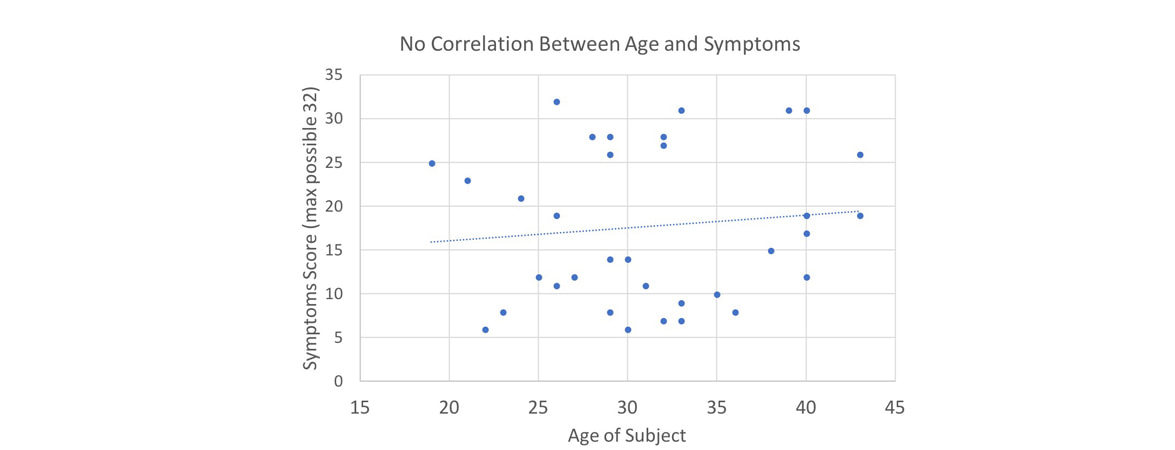|
Some lens companies will try to convince you that digital eye strain should be treated according to age. But this is far from a best practice—and a recent study* proves it, showing no correlation between age and severity of symptoms. In other words, if you choose the lens according to age alone, you might as well choose it randomly. How did the confusion between age and symptoms occur? Digital Eye Strain vs PresbyopiaBlurry vision is the symptom that causes this confusion. Blurry vision leads some lens companies to recommend treating digital eye strain like presbyopia. However, the two conditions are not the same. Blurry vision leads some lens companies to recommend treating digital eye strain like presbyopia." What is Digital Eye Strain?
Digital Eye Strain Symptoms:
What is Presbyopia?
Clearly, presbyopia and digital eye strain are two very different conditions: The word presbyopia comes from the Ancient Greek phrase “old man’s eyes.” Presbyopia vs Digital Eye Stain
Dispensing Appropriate Lenses for Digital Eye Strain
Treating digital eye strain requires a different approach. The main cause of digital eye strain is fatigue of the accommodative-convergence system. This fatigue may present itself as an accommodation lag, erratic convergence, or both. Visual instability is a hallmark of the syndrome. A digital eye strain sufferer instinctively reacts by squinting, staring, and blinking, in an attempt to regain control. Unity Relieve lenses were developed specifically for digital eye strain. They work by adding a small amount of add power in the lower part of the lens, stabilizing the eye and easing the squint-stare-blink response. The independent study mentioned above showed that subtle and gradual variations of power delivered the best results for reducing visual eye strain. Because digital eye strain symptoms can range from mild to severe, lenses feature different increments of added magnifying power, known as “bumps.” This power bump should be selected on the severity and frequency of their symptoms, not their age. Lens prescription is not driven by age, because the condition is not presbyopia. An age-based approach will frequently lead to over-prescribing, creating noticeable disturbances. The most effective solution? Prescribe based on the patient’s current symptoms and digital lifestyle, rather than age alone. An age-based approach will frequently lead to over-prescribing, creating noticeable disturbances." A recent, independent study* validates the performance of digital eye strain lenses. It found there was no correlation between age and severity of symptoms. The study showed that choosing the bump according to age alone is equivalent to choosing it randomly. Best Practices for Dispensing Digital Eye Strain LensesFollow these best practices for prescribing Unity Relieve:
If you’re still undecided, try Unity’s new, interactive lens matching tool. It helps determine a patient’s risk and severity of digital eye strain, and recommends a Unity lens based on the patient’s responses. Most importantly, avoid the pressure to prescribe on age alone. After all, age is just a number. And that number fails to reflect the very real factors causing digital eye strain for your patients, or the path for relief that they need. While prescribing on age alone seems like a quick and easy solution, this shortcut does not always provide the best results. Instead, consider Unity’s algorithm for prescribing lenses—designed to be effortless. With Unity, it’s easy to help your patients pick the perfect lens, because they are easy to dispense, easy to fit, easy to rely on, and effortless for your patients. How do you dispense for digital eye strain? Let us know in the comments section below *2018 Unity Relieve Independent Wearer Trial
0 Comments
Your comment will be posted after it is approved.
Leave a Reply. |
Don't Miss Out!
Subscribe to the In_Sight Newsletter to get the latest blog posts delivered directly to your inbox. Popular Posts
5 Digital Eye Strain Hacks to Enhance Patient and Practice Experience Changing Your Preferred Progressive Lens: A Blueprint for A Successful Switch (Part I) How Unity Via Helped this New Jersey Practice Overcome Change Anxiety Categories
All
|
©2024 Plexus Optix, Inc. All rights reserved.
Unity, SunSync, and TechShield are registered trademarks of Plexus Optix, Inc. All other brands or marks are the property of their respective owners.
Use of these marks, names, logos, and/or brands does not imply endorsement.
Unity, SunSync, and TechShield are registered trademarks of Plexus Optix, Inc. All other brands or marks are the property of their respective owners.
Use of these marks, names, logos, and/or brands does not imply endorsement.
Website by Eyefinity





 RSS Feed
RSS Feed
